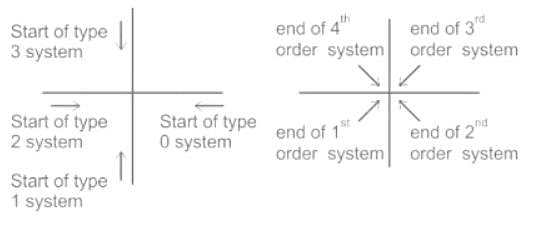Electronics and Communication Engineering (ECE) Exam > Electronics and Communication Engineering (ECE) Questions > Polar plot of sinusoidal transfer function is...
Start Learning for Free
Polar plot of sinusoidal transfer function is a plot of:
- a)magnitude and phase angle
- b)magnitude versus frequency
- c)phase angle versus frequency
- d)none of the above
Correct answer is option 'A'. Can you explain this answer?
Most Upvoted Answer
Polar plot of sinusoidal transfer function is a plot of:a)magnitude an...
Polar plot:
- The polar plot of a transfer function G(jω) is the plot of the magnitude of G(jω) versus the phase angle of G(jω) as ω is varied from 0 to positive infinity.
- For all pole systems, type indicates the starting point of the polar plot and order indicates the ending point of the polar plot.
The sinusoidal transfer function G(jω) is a complex function and it is given by
G(jω) = Re [G(jω)] + j Im [G(jω)]
G(jω) = |G(jω)| ∠ G(jω)
= M ∠ϕ Polar form
From the above equation,
G(jω) may be represented as a phasor of magnitude M and phase angle ϕ
The starting points (ω = 0) of a polar plot for different types of minimum phase systems is given below:

G(jω) = Re [G(jω)] + j Im [G(jω)]
G(jω) = |G(jω)| ∠ G(jω)
= M ∠ϕ Polar form
From the above equation,
G(jω) may be represented as a phasor of magnitude M and phase angle ϕ
The starting points (ω = 0) of a polar plot for different types of minimum phase systems is given below:

- As seen from the above figure, when a zero is added the type decreases, and the end of the polar plot shifts by +90°.
- When a pole is added, the type of the system increases, and hence the end of the polar plot shifts by -90°.
Therefore, the Polar plot of the sinusoidal transfer function is a plot of magnitude and phase angle.
Free Test
FREE
| Start Free Test |
Community Answer
Polar plot of sinusoidal transfer function is a plot of:a)magnitude an...
Definition:
Polar plot of a sinusoidal transfer function is a plot that shows the magnitude and phase angle of the transfer function as a function of frequency.
Explanation:
- Magnitude: The magnitude of the transfer function represents the ratio of the output amplitude to the input amplitude. It is plotted on the radial axis of the polar plot.
- Phase Angle: The phase angle of the transfer function represents the phase shift between the input and output signals. It is plotted on the angular axis of the polar plot.
Interpretation:
- The magnitude and phase angle of a sinusoidal transfer function provide valuable information about the system's behavior at different frequencies.
- By analyzing the polar plot, engineers can determine the system's stability, gain margin, and phase margin.
Significance:
- The polar plot helps in understanding how a system responds to different frequencies and aids in designing control systems.
- It is a useful tool for characterizing the frequency response of a system and identifying potential issues such as resonance or instability.
In conclusion, a polar plot of a sinusoidal transfer function is a representation of both magnitude and phase angle, making it a valuable tool for analyzing system behavior in the frequency domain.

|
Explore Courses for Electronics and Communication Engineering (ECE) exam
|

|
Similar Electronics and Communication Engineering (ECE) Doubts
Polar plot of sinusoidal transfer function is a plot of:a)magnitude and phase angleb)magnitude versus frequencyc)phase angle versus frequencyd)none of the aboveCorrect answer is option 'A'. Can you explain this answer?
Question Description
Polar plot of sinusoidal transfer function is a plot of:a)magnitude and phase angleb)magnitude versus frequencyc)phase angle versus frequencyd)none of the aboveCorrect answer is option 'A'. Can you explain this answer? for Electronics and Communication Engineering (ECE) 2025 is part of Electronics and Communication Engineering (ECE) preparation. The Question and answers have been prepared according to the Electronics and Communication Engineering (ECE) exam syllabus. Information about Polar plot of sinusoidal transfer function is a plot of:a)magnitude and phase angleb)magnitude versus frequencyc)phase angle versus frequencyd)none of the aboveCorrect answer is option 'A'. Can you explain this answer? covers all topics & solutions for Electronics and Communication Engineering (ECE) 2025 Exam. Find important definitions, questions, meanings, examples, exercises and tests below for Polar plot of sinusoidal transfer function is a plot of:a)magnitude and phase angleb)magnitude versus frequencyc)phase angle versus frequencyd)none of the aboveCorrect answer is option 'A'. Can you explain this answer?.
Polar plot of sinusoidal transfer function is a plot of:a)magnitude and phase angleb)magnitude versus frequencyc)phase angle versus frequencyd)none of the aboveCorrect answer is option 'A'. Can you explain this answer? for Electronics and Communication Engineering (ECE) 2025 is part of Electronics and Communication Engineering (ECE) preparation. The Question and answers have been prepared according to the Electronics and Communication Engineering (ECE) exam syllabus. Information about Polar plot of sinusoidal transfer function is a plot of:a)magnitude and phase angleb)magnitude versus frequencyc)phase angle versus frequencyd)none of the aboveCorrect answer is option 'A'. Can you explain this answer? covers all topics & solutions for Electronics and Communication Engineering (ECE) 2025 Exam. Find important definitions, questions, meanings, examples, exercises and tests below for Polar plot of sinusoidal transfer function is a plot of:a)magnitude and phase angleb)magnitude versus frequencyc)phase angle versus frequencyd)none of the aboveCorrect answer is option 'A'. Can you explain this answer?.
Solutions for Polar plot of sinusoidal transfer function is a plot of:a)magnitude and phase angleb)magnitude versus frequencyc)phase angle versus frequencyd)none of the aboveCorrect answer is option 'A'. Can you explain this answer? in English & in Hindi are available as part of our courses for Electronics and Communication Engineering (ECE).
Download more important topics, notes, lectures and mock test series for Electronics and Communication Engineering (ECE) Exam by signing up for free.
Here you can find the meaning of Polar plot of sinusoidal transfer function is a plot of:a)magnitude and phase angleb)magnitude versus frequencyc)phase angle versus frequencyd)none of the aboveCorrect answer is option 'A'. Can you explain this answer? defined & explained in the simplest way possible. Besides giving the explanation of
Polar plot of sinusoidal transfer function is a plot of:a)magnitude and phase angleb)magnitude versus frequencyc)phase angle versus frequencyd)none of the aboveCorrect answer is option 'A'. Can you explain this answer?, a detailed solution for Polar plot of sinusoidal transfer function is a plot of:a)magnitude and phase angleb)magnitude versus frequencyc)phase angle versus frequencyd)none of the aboveCorrect answer is option 'A'. Can you explain this answer? has been provided alongside types of Polar plot of sinusoidal transfer function is a plot of:a)magnitude and phase angleb)magnitude versus frequencyc)phase angle versus frequencyd)none of the aboveCorrect answer is option 'A'. Can you explain this answer? theory, EduRev gives you an
ample number of questions to practice Polar plot of sinusoidal transfer function is a plot of:a)magnitude and phase angleb)magnitude versus frequencyc)phase angle versus frequencyd)none of the aboveCorrect answer is option 'A'. Can you explain this answer? tests, examples and also practice Electronics and Communication Engineering (ECE) tests.

|
Explore Courses for Electronics and Communication Engineering (ECE) exam
|

|
Signup for Free!
Signup to see your scores go up within 7 days! Learn & Practice with 1000+ FREE Notes, Videos & Tests.
























